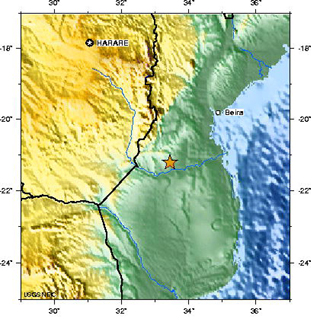 Severe
shaking awoke residents in Mozambique at 12:19 a.m. local time on Thursday,
as a magnitude-7.4 earthquake struck the seismically active region of East Africa,
according to the U.S. Geological Survey (USGS).
Severe
shaking awoke residents in Mozambique at 12:19 a.m. local time on Thursday,
as a magnitude-7.4 earthquake struck the seismically active region of East Africa,
according to the U.S. Geological Survey (USGS).The East African Rift Zone experienced a damaging magnitude-7.4 earthquake Thursday in Mozambique, centered about 215 kilometers southwest of Beira. Image courtesy of USGS.
The event was centered about 215 kilometers southwest of the city of Beira. Stemming from a shallow depth of 11 kilometers, however, the earthquake could be felt by people throughout Mozambique as well as in parts of the neighboring countries of Swaziland, Zambia, Zimbabwe and South Africa, according to USGS. At least five aftershocks immediately followed the main event, according the Associated Press, and seismologists expect more small tremors over the next week.
Shaking was strong enough to kill four people and injure at least 29 more, according to a Feb. 24 Agence France-Presse story. Also, USGS initial reports noted that buildings in Beira and Chimoyo sustained damage, and power outages darkened Mozambique's capital city Maputo, 535 kilometers south of the earthquake's epicenter.
Thursday's earthquake was not an entirely uncommon event within the East African Rift Zone, which runs north-south about 3,000 kilometers, from Ethiopia to Zambezi. The event Thursday stemmed from the southern end of the zone, which is being stretched by forces that could one day lead to East Africa splitting from the main continent (see Geotimes, Dec. 5, 2005). On Dec. 5, the zone produced a destructive shallow earthquake centered north of Mozambique in Tanzania — a magnitude-6.8 event that killed at least three people.

